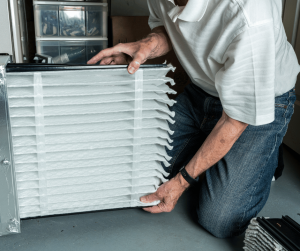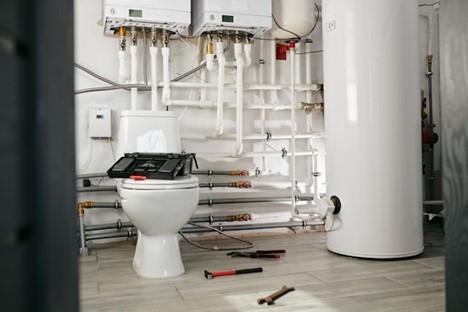
Everything You Need to Know About HVAC Furnace Filters
In the realm of home maintenance, few tasks are as crucial yet often overlooked as the regular replacement of HVAC furnace filters. These unassuming components play a pivotal role in not only maintaining indoor air quality but also in ensuring the longevity and efficiency of your heating, ventilation, and air conditioning (HVAC) system.
Properly functioning HVAC filters act as the first line of defense against airborne particles, dust, allergens, and contaminants that can circulate through your home’s ductwork. By capturing these pollutants, furnace filters prevent them from entering the HVAC system and subsequently spreading throughout your living spaces. This not only enhances the air quality within your home but also reduces the workload on your HVAC system, leading to lower energy consumption and fewer repair costs over time.
As part of a comprehensive approach to home maintenance, regular replacement of HVAC furnace filters should be a priority. This simple yet effective practice ensures that your HVAC system operates efficiently, providing comfort and peace of mind year-round.
Throughout this article, we’ll delve into the essential aspects of HVAC furnace filters, addressing common questions and providing practical advice to help you maintain a healthy home environment. From understanding the frequency of filter changes to selecting the right type of filter for your needs, we’ve got you covered.
How Often Should Furnace Filters Be Changed?
Regularly changing your HVAC furnace filters is essential to maintain optimal air quality and system performance. The frequency of filter changes depends on several factors, including the type of filter used, household conditions, and local air quality. Here’s a guide to help you determine how often you should replace your furnace filters:
- Standard Filters (Fiberglass): These filters typically need to be replaced every 1 to 3 months. They are affordable but offer basic filtration.
- Pleated Filters: With better filtration capabilities, pleated filters should be changed every 3 to 6 months. They are more effective at capturing smaller particles like dust and pollen.
- HEPA Filters: High-Efficiency Particulate Air (HEPA) filters provide the highest level of filtration and are recommended for allergy sufferers or homes with pets. They generally last 6 to 12 months before needing replacement.
Factors influencing the replacement frequency include:
- Usage Patterns: Homes with pets, smokers, or frequent guests may require more frequent filter changes.
- Allergies and Health Concerns: Individuals with allergies or respiratory conditions benefit from more frequent filter changes to maintain indoor air quality.
- Local Environment: Areas with high pollen levels, dust, or pollution may necessitate more frequent filter replacements.
How Do I Know Which HVAC Filter I Need?
Choosing the right HVAC filter involves considering several factors:
- MERV Rating: Minimum Efficiency Reporting Value (MERV) indicates a filter’s ability to capture particles of varying sizes. Higher MERV ratings (between 8 to 13) provide better filtration but may require more frequent changes due to increased resistance to airflow.
- Compatibility: Ensure the filter size matches your HVAC system’s specifications. Most filters have dimensions printed on the frame for easy identification.
- Specific Needs: Tailor your choice based on specific needs such as allergy relief, dust reduction, or energy efficiency.
By understanding these considerations, you can select an HVAC filter that meets your household’s needs effectively, ensuring clean indoor air and optimal HVAC system performance.
What Type of Filter is Best for HVAC?
Choosing the best HVAC filter involves considering factors such as filtration efficiency, cost-effectiveness, and specific household needs. Here’s a comparison of common HVAC filter types to help you make an informed decision:
Types of HVAC Filters:
- Fiberglass Filters:
- Efficiency: Basic filtration for larger particles.
- Cost: Affordable, but lower filtration efficiency compared to other types.
- Suitable For: Homes with minimal air quality concerns and budget constraints.
- Pleated Filters:
- Efficiency: Higher filtration efficiency than fiberglass, capturing smaller particles like dust and pollen.
- Cost: Moderately priced.
- Suitable For: Most households seeking improved air quality without the cost of HEPA filters.
- HEPA Filters (High-Efficiency Particulate Air):
- Efficiency: Highest level of filtration, capturing up to 99.97% of particles down to 0.3 microns in size.
- Cost: More expensive upfront, but cost-effective for allergy sufferers and those needing superior air quality.
- Suitable For: Homes with allergies, pets, or individuals sensitive to airborne particles.
Factors to Consider:
- Allergy Relief: HEPA filters are recommended for allergy relief due to their superior filtration capabilities.
- Cost vs. Efficiency: Balance your budget with the level of filtration needed for your household’s air quality concerns.
- System Compatibility: Ensure your HVAC system can accommodate the filter’s airflow requirements, especially with higher MERV-rated filters.
Recommendation:
- General Recommendation: Pleated filters with a MERV rating between 8 to 13 offer a good balance of efficiency and cost-effectiveness for most households.
- Specialized Needs: Consider HEPA filters for superior air quality in homes with specific health concerns or environmental conditions.
Choosing the right HVAC filter ensures cleaner indoor air and prolongs the lifespan of your HVAC system, contributing to a healthier and more comfortable home environment.
Are Furnace and HVAC Filters the Same?
Understanding the terminology surrounding HVAC and furnace filters can help clarify their roles and differences:
Furnace Filters:
- Purpose: Furnace filters are specifically designed to protect the furnace from dust, dirt, and debris that can damage its components.
- Location: Typically installed near the furnace unit itself, often in the return air duct or within the furnace cabinet.
- Function: Primarily focuses on protecting the furnace and ensuring its efficiency and longevity.
HVAC Filters:
- Purpose: HVAC filters refer to filters used in both heating and cooling systems, encompassing a broader range of air quality control.
- Location: Positioned in the return air ducts or air handler unit of the HVAC system, they filter air before it enters the system to be heated or cooled.
- Function: HVAC filters not only protect the HVAC system but also improve indoor air quality by capturing airborne particles.
Clarification:
- While the terms “furnace filter” and “HVAC filter” are sometimes used interchangeably, they serve distinct purposes.
- Overlap: In many residential HVAC systems, the same filter serves both the furnace and the air conditioning unit, blurring the distinction between furnace and HVAC filters.
Common Misconceptions:
- Size and Compatibility: Ensure the filter size matches your HVAC system’s specifications to avoid inefficiencies or damage.
- Replacement: Regularly replacing both furnace and HVAC filters is crucial for maintaining system efficiency and indoor air quality.
By understanding these differences, homeowners can make informed decisions regarding filter maintenance and selection, ensuring both their furnace and HVAC systems operate effectively.
How Do I Change the Filter in My HVAC Furnace?
Regularly changing your HVAC furnace filter is essential for maintaining air quality and system efficiency. Follow these steps to replace your filter:
Step-by-Step Guide:
- Turn Off HVAC System:
- Before starting, turn off your HVAC system to ensure safety.
- Locate the Filter:
- Find the filter access panel. It’s typically located near the return air duct or inside the furnace unit.
- Remove the Old Filter:
- Carefully slide out the old filter from its slot. Note the direction of airflow indicated on the filter frame.
- Choose the Right Replacement:
- Select a new filter that matches the size and type recommended for your HVAC system.
- Install the New Filter:
- Slide the new filter into place, ensuring it fits snugly within the slot and aligning it with the airflow direction arrow.
- Close the Access Panel:
- Securely close the filter access panel to prevent air leaks.
- Turn On HVAC System:
- Restore power to your HVAC system and monitor its operation to ensure proper airflow.
Maintenance Tips:
- Frequency: Refer to manufacturer guidelines or replace filters every 1 to 6 months, depending on filter type and household conditions.
- Quality Filters: Opt for high-quality filters with a MERV rating suitable for your air quality needs.
- Check Regularly: Inspect filters monthly, especially during peak usage seasons, and replace as needed.
Safety Precautions:
- Safety First: Always follow manufacturer instructions and safety precautions when handling HVAC components.
- Professional Assistance: For complex installations or if unsure, consider consulting a professional HVAC technician.
By regularly changing your HVAC furnace filter, you ensure cleaner indoor air and prolong the life of your HVAC system, contributing to a healthier and more efficient home environment.
Do I Need Both a Furnace Filter and a Return Air Filter?
Understanding the roles of furnace filters and return air filters can help determine if both are necessary for your HVAC system:
Furnace Filter:
- Purpose: The furnace filter protects the furnace from dust and debris, ensuring its efficiency and longevity.
- Location: Typically located near the furnace unit in the return air duct or within the furnace cabinet.
- Function: Primarily focuses on filtering air before it enters the furnace for heating.
Return Air Filter (HVAC Filter):
- Purpose: The return air filter, part of the HVAC system, filters air before it reaches the air handler or furnace for heating or cooling.
- Location: Positioned in the return air ducts or air handler unit of the HVAC system.
- Function: Improves indoor air quality by capturing airborne particles before they circulate throughout the home.
Determining Necessity:
- Single-Filter Systems: In many residential HVAC systems, a single filter serves both the furnace and air conditioning unit, fulfilling both roles effectively.
- Additional Filters: Depending on your HVAC setup and air quality needs, additional return air filters may be recommended for enhanced filtration.
Recommendations:
- Maintenance: Regularly replace filters to maintain system efficiency and indoor air quality.
- Consultation: Consult with an HVAC professional to assess your system’s needs and ensure proper filtration.
Understanding the distinctions between furnace and return air filters allows homeowners to make informed decisions regarding filter maintenance and replacement. By ensuring filters are correctly installed and regularly replaced, you can optimize HVAC system performance and indoor air quality effectively.
Maintaining clean indoor air and ensuring the efficient operation of your HVAC system hinges on one simple yet crucial task: regularly changing your HVAC furnace filters. These filters not only protect your heating and cooling equipment from dust and debris but also improve indoor air quality by capturing allergens and pollutants.
Throughout this guide, we’ve explored the importance of HVAC furnace filters and provided practical advice to help you navigate the world of filter maintenance:
- Frequency of Filter Changes: Regularly replace your furnace filter every 1 to 6 months, depending on filter type and household conditions.
- Choosing the Right Filter: Consider factors like MERV rating, filter type, and household needs to select the most suitable HVAC filter.
- Understanding Terminology: Clarify the differences between furnace filters and HVAC filters to make informed decisions.
By integrating these practices into your home maintenance routine, you not only ensure cleaner indoor air but also extend the lifespan of your HVAC system, ultimately saving on energy costs and potential repair expenses.
For personalized recommendations or assistance with your HVAC system, consider consulting with a professional technician who can provide tailored solutions to meet your specific needs.
Remember, a proactive approach to HVAC maintenance not only enhances comfort but also contributes to a healthier living environment for you and your family.
- How a Simplified Service Model Benefits Both Homeowners and Franchisees Alike
- Why Home Maintenance Packages Save You More Than Just Money
- Essential Home Tasks You Shouldn’t Ignore and Why Hiring Professionals is the Smarter Choice
- How Regular Gutter Maintenance Can Save You Money in the Long Run
- Siding Washing: The Ultimate Guide to Cleaning and Maintaining Your Home's Exterior


